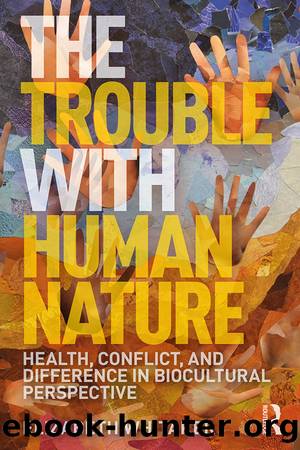The Trouble with Human Nature by Elizabeth D. Whitaker

Author:Elizabeth D. Whitaker [Whitaker, Elizabeth D.]
Language: eng
Format: epub
Tags: Psychology, Movements, Humanistic, Social Science, Anthropology, General
ISBN: 9781315451725
Google: JiAlDwAAQBAJ
Publisher: Taylor & Francis
Published: 2017-02-03T03:25:07+00:00
* * *
Degree of sexual dimorphism high moderate moderate to low very low
Scale from low to males mate with males mate males mate males mate
high male tendency towards monogamy multiple females and restrict other malesâ mating opportunities with multiple females with one to a few females with one female
The other half of the story is that human females also have an evolutionary history of one to two partners besides the long-term mate, as indicated by the ratio between testes weight and body weight in males. Across species, where females mate with more than one male, males have larger testes which produce more abundant and higher density sperm. Sperm competition also occurs through behavior, such as the chimpanzee strategy of mating last and consequently delivering a higher number of sperm. Human males presented pornographic images as part of an experimental design produce more sperm-dense ejaculate if the pictures include one woman with two men than if they show three women (Kilgallon and Simmons 2005). Separation from a partner has the same effect: the longer the time apart, the greater the number of active sperm released (Shackelford and Goetz 2007).
Sperm competition is intense in species such as chimpanzees and bonobos, in which females mate with a dozen or more males multiple times during estrus. The males have outsized testes as a proportion of body size. In contrast, male gorillas have the same size testes as human males but more than twice the body weight. Male gorillas do not have to worry about their females mating with other gorillas, since groups are stable and relatively isolated from one another.
Testes weight as a proportion of body weight is 0.25â0.27% in chimpanzees and bonobos, 0.08â1.0% in humans and gibbons, 0.05% in orangutans, and 0.03% in gorillas.2 As shown in Table 7.2, this suggests that female humans have an evolutionary history of coupling with a number of males that falls closer to the one mate seen in gorillas and orangutans, and the many mates typical of species that live in multi-male, multi-female groups such as chimpanzees.
Table 7.2 Ratio of testes to body size in relation to female tendency towards monogamy in primates
Chimpanzees Bonobos Humans Marmosets Tamarins Gorillas Orangutans
Download
This site does not store any files on its server. We only index and link to content provided by other sites. Please contact the content providers to delete copyright contents if any and email us, we'll remove relevant links or contents immediately.
Cecilia; Or, Memoirs of an Heiress — Volume 1 by Fanny Burney(32092)
Cecilia; Or, Memoirs of an Heiress — Volume 3 by Fanny Burney(31481)
Cecilia; Or, Memoirs of an Heiress — Volume 2 by Fanny Burney(31435)
The Great Music City by Andrea Baker(30931)
We're Going to Need More Wine by Gabrielle Union(18664)
All the Missing Girls by Megan Miranda(14855)
Pimp by Iceberg Slim(13828)
Bombshells: Glamour Girls of a Lifetime by Sullivan Steve(13718)
Fifty Shades Freed by E L James(12936)
Talking to Strangers by Malcolm Gladwell(12916)
Norse Mythology by Gaiman Neil(12879)
For the Love of Europe by Rick Steves(11666)
Crazy Rich Asians by Kevin Kwan(8912)
Mindhunter: Inside the FBI's Elite Serial Crime Unit by John E. Douglas & Mark Olshaker(8751)
The Lost Art of Listening by Michael P. Nichols(7190)
Enlightenment Now: The Case for Reason, Science, Humanism, and Progress by Steven Pinker(6891)
The Four Agreements by Don Miguel Ruiz(6343)
Bad Blood by John Carreyrou(6295)
Weapons of Math Destruction by Cathy O'Neil(5872)
